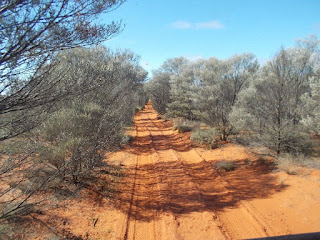We said farewell to our last camp spot at 8.30 am. The busy Murray Valley Highway was quite noisy during the night but our sleep was OK.
Our trip home was uneventful with a stop in Shepparton for Food Shopping and lunch. John enjoyed his favourite, a foccacia from the Food Mall.
We were soon back on the Hume Highway with many vehicles. The last avenue of trees we drove through was along the Snow Road. High eucalypts gave us no problems, unlike the low and spreading mulgas of the inland tracks.
'Kyamba' welcomed us with our lovely Leucoxylon in bloom. Cynthia had been this morning and put a bunch of these bright flowers on my table as well as a welcoming container of soup for dinner this evening. Very soon I had a 'Welcome Home' phone call from Anneshka. Yes, we are pleased to be home after being away for 8 weeks. EC is really quite small inside so we are both appreciating much more room to live in. Having said that, the rig provides us with many comforts while on Safari. We have seen some lovely new places and added some new experiences to our list of pleasures....My favourite day was driving through the wild flowers to Mt Augusta. Success in identifying quite a large number of new mallee eucalypts was good fun and challenging.
 |
| Avenue of eucalypts along the Snow Road from Glenrowan to Oxley |
 |
| Leucoxylon in bloom at 'Kyamba', Milawa. |















































